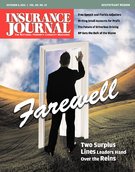Florida’s hurricane fund chief is warning that the state-created fund used to help insurers pay off claims after a big storm is in danger.
The state has relied on a hurricane fund ever since Hurricane Andrew devastated South Florida nearly 20 years ago.
Jack Nicholson, the chief operating officer of the fund, told state legislators recently that the fund is on “shaky ground.” He said ongoing turmoil in the world financial markets is raising questions about whether the fund could borrow enough money to help insurers after a hurricane.
This year the fund is providing $18.5 billion of coverage, and while it has more than $7 billion worth of cash on hand, it would still need to borrow another $11 billion.
“I think we are dangerously overexposed considering the current reality of the marketplace,” Nicholson said. “… It scares me to death where we are.”
Nicholson used the warnings as part of a pitch to state lawmakers to scale back the size of the Florida Hurricane Catastrophe Fund. That would likely cause premiums to rise but it has the backing of key Republicans, including Gov. Rick Scott.
Every insurer in Florida must purchase coverage from the “Cat Fund” as it also called. The fund provides a backstop to insurers at a rate that is generally cheaper than reinsurance sold by private companies. Nicholson estimated that this low-cost option probably results in premiums being about 25 percent cheaper.
If a storm causes enough damage an insurer can ask for reimbursement from the fund. If the fund runs out of cash due to a big storm, it borrows money to pay insurers.
The state pays off its debts with an assessment, or what some call a “hurricane tax,” that is placed on nearly every insurance policy in the state, including auto policies. Right now, insureds are paying off charges due primarily to Hurricane Wilma.
Nicholson, however, said he’s less worried about future hikes in the “hurricane tax” because right now he’s not sure he can even borrow enough money. He said the turbulence in the financial markets this summer has created “tremendous uncertainty.”
The Republican-led Legislature agreed with Gov. Charlie Crist to greatly expand the size of the fund in 2007 as part of an effort to lower insurance rates. Two years later legislators started whittling the fund back down but Nicholson says more needs to be done. “The Cat Fund needs to be right-sized,” Nicholson said. “It’s too much when you are expecting to depend on 10 billion or greater of debt.”
State Sen. Alan Hays, R-Umatilla, said he considered it “fraud” to force insurers to buy coverage if there is no guarantee the fund can pay for storm damages. “We’re taking a tremendous gamble which I find unacceptable,” Hays said.
But any move to change the fund could run into opposition from coastal lawmakers concerned about raising insurance rates during bad economic times.
“We need to go very slowly,” said State Sen. Mike Fasano, R-New Port Richey. “I have great concerns of the ramifications of what this will do to every property insurance policy holder in the state. We’re not just talking about homeowners. We’re talking about mobile home owners, condo owners and small business owners.”
The governor agrees with Nicholson. He said he would prefer insurers to rely on other sources of help instead of utilizing the state-created hurricane fund. “I believe free markets are efficient so I would like to downsize the Cat Fund responsibly,” Scott said.
Topics Florida Catastrophe Natural Disasters Carriers Hurricane
Was this article valuable?
Here are more articles you may enjoy.


 Study Urges Rethinking of Disaster Management in Era of Compounding Events
Study Urges Rethinking of Disaster Management in Era of Compounding Events  Beryl’s Remnants Spawned 4 Indiana Tornadoes, Including an EF-3: NWS
Beryl’s Remnants Spawned 4 Indiana Tornadoes, Including an EF-3: NWS  What Happened to Reinsurance ‘Class of 2023’? Hard Market Defies Age-Old Patterns.
What Happened to Reinsurance ‘Class of 2023’? Hard Market Defies Age-Old Patterns.  Deere Retreats From Diversity Measures After Online Attacks
Deere Retreats From Diversity Measures After Online Attacks 


